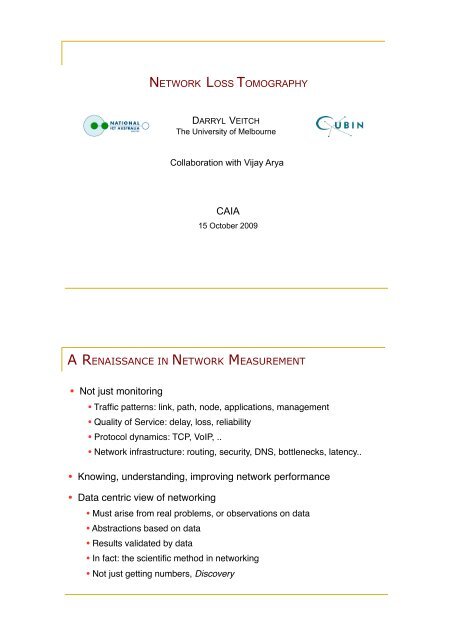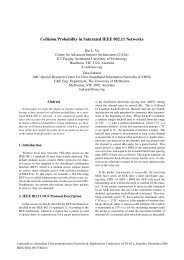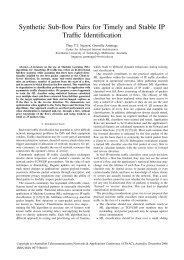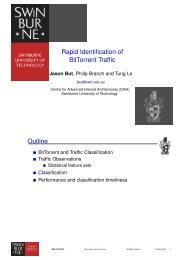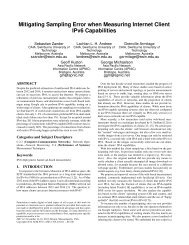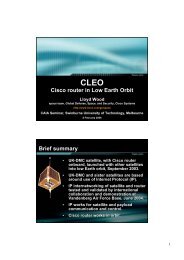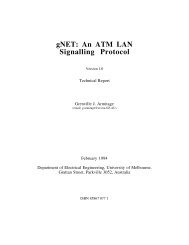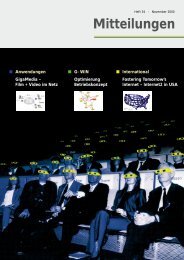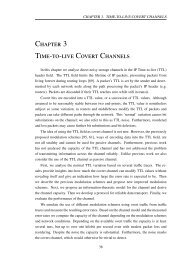Slides - CAIA
Slides - CAIA
Slides - CAIA
You also want an ePaper? Increase the reach of your titles
YUMPU automatically turns print PDFs into web optimized ePapers that Google loves.
NETWORK LOSS TOMOGRAPHY<br />
DARRYL VEITCH<br />
The University of Melbourne<br />
Collaboration with Vijay Arya<br />
<strong>CAIA</strong><br />
15 October 2009<br />
A RENAISSANCE IN NETWORK MEASUREMENT<br />
• Not just monitoring"<br />
• Traffic patterns: link, path, node, applications, management"<br />
• Quality of Service: delay, loss, reliability"<br />
• Protocol dynamics: TCP, VoIP, .."<br />
• Network infrastructure: routing, security, DNS, bottlenecks, latency.."<br />
• Knowing, understanding, improving network performance"<br />
• Data centric view of networking"<br />
• Must arise from real problems, or observations on data"<br />
• Abstractions based on data"<br />
• Results validated by data"<br />
• In fact: the scientific method in networking"<br />
• Not just getting numbers, Discovery "
THE RISE OF MEASUREMENT<br />
• Papers between 1966-87 ( P.F. Pawlita, ITC-12, Italy )"<br />
• Queueing theory: " "several thousand"<br />
• Traffic measurement: "around 50 "<br />
• Now have dedicated conferences:"<br />
• Passive and Active Measurement Conference (PAM) "2000 …"<br />
• ACM Internet Measurement Conference (IMC) " "2001 ..."<br />
IMC 2010 : MELBOURNE !<br />
• Conference: ~ Nov 1-3 "<br />
• Deadline: ~ May 1"<br />
• Venue: BMW Edge at Federation Square"
IMC 2010 : MELBOURNE !<br />
• Conference: ~ Nov 1-3 "<br />
• Deadline: ~ May 1"<br />
• Venue: BMW Edge at Federation Square"<br />
ACTIVE VERSUS PASSIVE MEASUREMENT<br />
• Typical Passive Aims"<br />
• “At-a-point” or “Network Core”"<br />
• Link utilisation, Link traffic patterns, Server workloads"<br />
• Long term monitoring:"<br />
Dimensioning, Capacity Planning, Source modelling "<br />
• Engineering view: Network performance"<br />
• Typical Active Aims"<br />
• “End-to-End” or “Network edge”"<br />
• End-to-End Loss, Delay, Connectivity, “Discovery” ….."<br />
• Long/short term monitoring: Network health; Route state"<br />
• Internet view: Application performance and robustness"
TOMO - GRAPHY<br />
Tomos!<br />
section"<br />
Graphia!<br />
writing"
EXAMPLES OF TOMOGRAPHY<br />
• Atom probe tomography (APT) "<br />
• Computed tomography (CT) (formerly CAT) "<br />
• Cryo-electron tomography (Cryo-ET)"<br />
• Electrical impedance tomography (EIT)"<br />
• Magnetic resonance tomography (MRT)"<br />
• Optical coherence tomography (OCT)"<br />
• Positron emission tomography (PET)"<br />
• Quantum tomography"<br />
• Single photon emission computed tomography (SPECT)"<br />
• Seismic tomography"<br />
• X-ray tomography "<br />
COMPUTED TOMOGRAPHY
NETWORK TOMOGRAPHY<br />
Began with Vardi [1996]"<br />
“Network Tomography: estimating source-destination traffic intensities from link data”"<br />
Classes of Inversion Problems"<br />
• End-to-end measurements "! "internal metrics"<br />
• Internal measurements "! "path metrics"<br />
The Metrics"<br />
• Link Traffic" "(volume, variance) (Traffic Matrix estimation)"<br />
• Link Loss " "(average, temporal)"<br />
• Link Delay" "(variance, distribution)"<br />
• Link Topology"<br />
• Path Properties "(network `krigingʼ)"<br />
• Joint problems "(use loss or delay to infer topology) "<br />
THE EARLY LITERATURE (INCOMPLETE!)<br />
• Traffic Matrix Tomography"<br />
• AT&T "( Zhang, Roughan, Donoho et al. )"<br />
• Sprint ATL " "( Nucci, Taft et al. )"<br />
• Loss/Delay/Topology Tomography"<br />
• AT&T "( Duffield, Horowitz, Lo Presti, Towsley et al. )"<br />
• Rice "( Coates, Nowak et al. )"<br />
• Evolution:"<br />
• loss, delay ! topology"<br />
• Exact MLE ! EM MLE ! Heuristics"<br />
• Multicast ! Unicast (striping )"
ACTIVE PROBING VERSUS NETWORK TOMOGRAPHY<br />
• Active Probing"<br />
• Typically over a single path"<br />
• Use tandem FIFO queue model"<br />
• Exploit discrete packet effects in semi-heuristic queueing analysis"<br />
• Typical metrics: "link capacities, available bandwidth"<br />
• Network Tomography"<br />
• Typically “network wide”: multiple destinations and/or sources"<br />
• Simple black box node/link models, strong assumptions"<br />
• Classical inference with twists"<br />
• Typical metrics: "per link/path loss/delay/throughput "<br />
BROADER VISION OF NETWORK INFERENCE<br />
• Active Probing"<br />
• solving formal problems in inverse queueing"<br />
• seeking optimal probing methods and methodologies"<br />
• Network Tomography"<br />
• black box models -> queueing compatible models"<br />
• trees -> general network topologies"<br />
• Pathways to Impact"<br />
• unimplementable research analysis -> tools for consumer watchdogs"<br />
• specialist software -> smart phone apps"<br />
• Networks/Measurement Disconnect"<br />
• measurement friendly networks (building tomography into the NBN)"<br />
• underlying timing infrastructure (RADclock project)"
TWO PROBLEMS IN LOSS TOMOGRAPHY OVER TREES<br />
• Removing the temporal independence assumption"<br />
Arya, Duffield, Veitch, 2007"<br />
• Exploiting Sparsity"<br />
Arya, Veitch, 2009 (ongoing)"<br />
LOSS TOMOGRAPHY USING MULTICAST PROBING<br />
1 0 1 1<br />
1 1 1 0<br />
...<br />
...<br />
multicast<br />
probes<br />
1 0 0 1<br />
! 1<br />
Loss Estimator<br />
Loss rates in<br />
logical Tree<br />
!<br />
7
FROM LINK PASSAGE TO PATH PASSAGE PROBABILITIES<br />
Path probabilities: only ancestors matter<br />
Sufficient to estimate path probabilities<br />
ACCESSING INTERNAL PATHS<br />
ESTIMATION: JOINT PATH PASSAGE PROBABILITY,<br />
SINGLE PROBE<br />
…<br />
1 0<br />
0 1<br />
1 1<br />
1 1<br />
0 0<br />
…<br />
1<br />
1<br />
1<br />
1<br />
0<br />
…<br />
Aim: estimate<br />
Obtain a quadratic in<br />
Original MINC loss estimator for binary tree<br />
[Cáceres,Duffield, Horowitz, Towsley 1999]"<br />
10 / 19
OBTAIN PATHS RECURSIVELY<br />
ESTIMATION: JOINT PATH PASSAGE PROBABILITY,<br />
SINGLE PROBE<br />
TEMPORAL INDEPENDENCE: HOW FAR TO RELAX ?<br />
Before<br />
After<br />
• Spatial:<br />
link loss processes independent<br />
• Temporal:<br />
link loss processes Bernoulli<br />
• Parameters: link passage probabilities<br />
• Spatial:<br />
link loss processes independent<br />
• Temporal:<br />
link loss processes stationary, ergodic<br />
• Parameters: joint link passage probabilities over index sets<br />
Full characterisation/identification possible!<br />
10 / 19
TARGET LOSS CHARACTERISTIC<br />
• Loss run-length distribution ( density, mean )<br />
• Importance<br />
…<br />
Loss/pass bursts<br />
• Impacts delay sensitive applications like VoIP (FEC tuning)<br />
• Characterizes bottleneck links<br />
• Sufficiency of joint link passage probabilities<br />
e.g.<br />
• Mean Loss-run length<br />
• Loss-run distribution<br />
…<br />
Pr<br />
1 2 3 …<br />
Loss-run length<br />
ACCESSING TEMPORAL PARAMETERS: GENERAL PROPERTIES<br />
7
JOINT PASSAGE PROBABILITIES<br />
• Joint link passage probability<br />
• Joint path passage probability<br />
ESTIMATION: JOINT PATH PASSAGE PROBABILITY<br />
No of equations<br />
equal to degree of node k<br />
computed recursively<br />
over index sets<br />
= 0 for
ESTIMATION: JOINT PATH PASSAGE PROBABILITY<br />
• Estimation of in general trees<br />
• Requires solving polynomials with degree equal to the degree of node k<br />
Numerical computations for trees with large degree<br />
• Recursion over smaller index sets<br />
• Simpler variants<br />
• Subtree-partitioning<br />
Requires solutions to only linear or quadratic equations<br />
No loss of samples<br />
Also simplifies existing MINC estimators<br />
• Avoid recursion over index sets by considering only<br />
subsets of receiver events which imply<br />
SIMULATION EXPERIMENTS<br />
• Setup"<br />
• Loss process"<br />
• Discrete-time Markov chains"<br />
• On-off processes: pass-runs geometric, loss-runs truncated Zipf"<br />
• Estimation"<br />
• Passage probability"<br />
• Joint passage probability for a pair of consecutive probes"<br />
• Mean loss-run length: "<br />
• Relative error: "<br />
... ...
EXPERIMENTS<br />
• Estimation for shared link in case of two-receiver binary tree<br />
EXPERIMENTS<br />
Markov<br />
chain<br />
On-off<br />
process<br />
• Estimation for shared link in case of two-receiver binary tree, continued..<br />
Markov<br />
chain<br />
On-off<br />
process
EXPERIMENTS<br />
• Estimation of for larger trees<br />
Link 1<br />
VARIANCE<br />
• Estimation for shared link in case of tertiary tree<br />
Trees taken from router-level map of AT&T<br />
network produced by Rocketfuel<br />
(2253 links, 731 nodes)<br />
Random shortest path multicast trees with<br />
32 receivers. Degree of internal nodes from<br />
2 to 6, maximum height 6<br />
GM: general temporal<br />
GS: subtree version<br />
SM: simplified OR<br />
SS: subtree version<br />
SE: subtree & AND<br />
if<br />
I = {i}<br />
M, S, E
CONCLUSIONS<br />
• Estimators for temporal loss parameters, in addition to loss rates"<br />
• Estimation of any joint probability possible for a pattern of probes"<br />
• Class of estimators to reduce computational burden"<br />
• Subtree-partition: simplifies existing MINC estimators"<br />
• Future work"<br />
• Asymptotic variance"<br />
• MLE for special cases (Markov chains)"<br />
• Hypothesis tests "<br />
• Experiments with real traffic "<br />
TWO PROBLEMS IN LOSS TOMOGRAPHY OVER TREES<br />
• Removing the temporal independence assumption"<br />
Arya, Duffield, Veitch, 2007"<br />
• Exploiting Sparsity"<br />
Arya, Veitch, 2009 (ongoing)"
CONCLUSIONS<br />
• Network Tomography has many guises and flavours"<br />
• Many interesting problems remain !"<br />
Thank you


